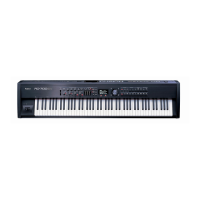62
Using the Convenient Functions in Performances
When any of the “TW-Organ 1–10” Tones is selected for any of the INTERNAL Zone
(UPPER 1, UPPER 2, LOWER 1, LOWER 2), you can perform in “Tone Wheel mode,” in
which the creation of organ sounds is simulated.
An organ features nine “harmonic bars” that can be drawn in and out, and by using the
bars in different combinations of positions, a variety of different tones can be created.
Different “Feet” are assigned to each bar, with the pitches of the sounds being
determined by these “Feet.” You can simulate the creation of tones using the harmonic
bars by assigning Feet to the ZONE LEVEL sliders.
While there are only four ZONE LEVEL sliders, you can switch the Feet setting by turning
the ZONE SWITCH buttons on and off, thus allowing you to assign eight Feet settings to
the sliders.
fig.Q2-11p
1.
Bring up the Tone screen (p. 29), then press the [ORGAN] button.
If the Tone screen is not currently displayed, press the ONE TOUCH [PIANO] button, then press
the [ORGAN] button.
2.
Use the [DEC] [INC] buttons or the VALUE dial to select one of the “TW-Organ 1–10”
Tone.
3.
Press the Cursor [ ] button.
Simulating the Creation of Organ Tones (Tone Wheel Mode)
What Are “Feet?”
Feet basically refers to the lengths of pipe used in pipe organs. The length of pipe used
to produce the reference pitch (the fundamental) for the keyboard is eight feet. Reducing
the pipe to half its length produces a pitch one octave higher; conversely, doubling the
pipe length creates a pitch one octave lower. Therefore, a pipe producing a pitch one
octave below that of the reference of 8' (eight feet) would be 16'; for one octave above
the reference, the pipe would be 4', and to take the pitch up yet another octave it would
be shortened to 2'.
RD-700GX_e.book 62 ページ 2008年2月13日 水曜日 午後5時49分

